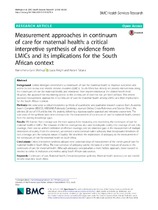| dc.contributor.author | Mothupi, Mamothena Carol | |
| dc.contributor.author | Knight, Lucia | |
| dc.contributor.author | Tabana, Hanani | |
| dc.date.accessioned | 2019-10-15T07:16:35Z | |
| dc.date.available | 2019-10-15T07:16:35Z | |
| dc.date.issued | 2018 | |
| dc.identifier.citation | Mothupi, M., Knight, L., & Tabana, H. (2018). Measurement approaches in continuum of care for maternal health: a critical interpretive synthesis of evidence from LMICs and its implications for the South African context. BMC Health Services Research, 18(1). doi: 10.1186/s12913-018-3278-4 | en_US |
| dc.identifier.issn | 1472-6963 | |
| dc.identifier.uri | https://doi.org/10.1186/s12913-018-3278-4 | |
| dc.identifier.uri | http://hdl.handle.net/10566/5040 | |
| dc.description.abstract | Background: Global strategies recommend a continuum of care for maternal health to improve outcomes and
access to care in low and middle income countries (LMICs). South Africa has already set priority interventions along
the continuum of care for maternal health, and mandated their implementation at the district health level.
However, the approach for monitoring access to this continuum of care has not yet been defined. This review
assessed measurement approaches in continuum of care for maternal health among LMICs and their implications
for the South African context.
Methods: We conducted a critical interpretive synthesis of quantitative and qualitative research sourced from Academic
Search Complete (EBSCO), MEDLINE (Pubmed), Cambridge Journals Online, Credo Reference and Science Direct. We
selected 20 out of 118 articles into the analysis, following a rigorous quality appraisal and relevance assessment. The
outcomes of the synthesis were new constructs for the measurement of continuum of care for maternal health, derived
from the existing knowledge gaps.
Results: We learned that coverage was the main approach for measuring and monitoring the continuum of care for
maternal health in LMICs. The measure of effective coverage was also used to integrate quality into coverage of care. Like
coverage, there was no uniform definition of effective coverage, and we observed gaps in the measurement of multiple
dimensions of quality. From the evidence, we derived a new construct called adequacy that incorporated timeliness of
care, coverage, and the complex nature of quality. We described the implications of adequacy to the measurement of
the continuum of care for maternal health in South Africa.
Conclusions: Critical interpretive synthesis allowed new understandings of measurement of the continuum of care for
maternal health in South Africa. The new construct of adequacy can be the basis of a new measure of access to the
continuum of care for maternal health. Although adequacy conceptualizes a more holistic approach, more research is
needed to derive its indicators and metrics using South African data sources. | en_US |
| dc.language.iso | en | en_US |
| dc.publisher | Springer Nature | en_US |
| dc.subject | Continuum of care | en_US |
| dc.subject | Maternal health | en_US |
| dc.subject | Critical interpretive synthesis | en_US |
| dc.subject | Maternal health services | en_US |
| dc.subject | Low and middle income countries | en_US |
| dc.title | Measurement approaches in continuum of care for maternal health: a critical interpretive synthesis of evidence from LMICs and its implications for the South African context | en_US |
| dc.type | Article | en_US |

